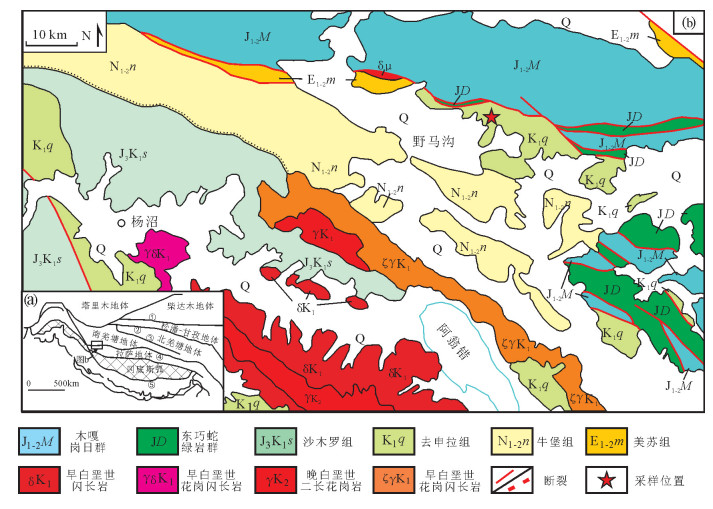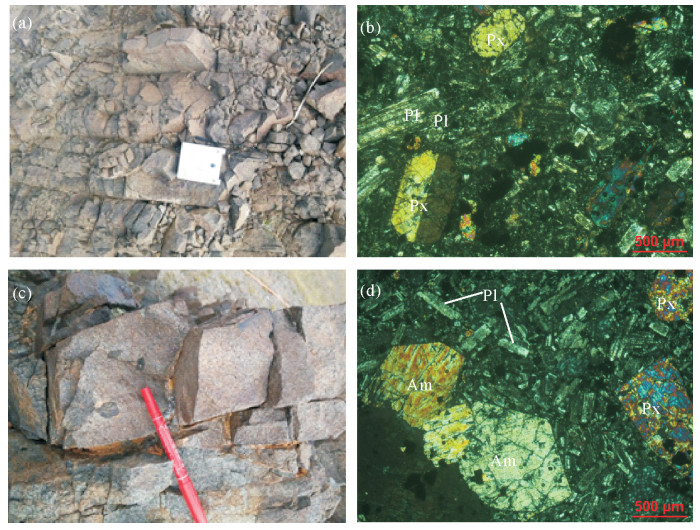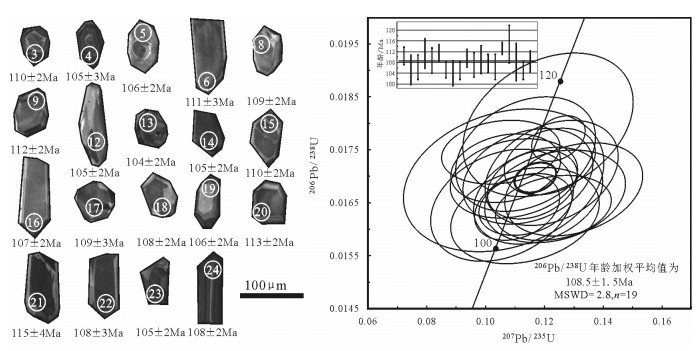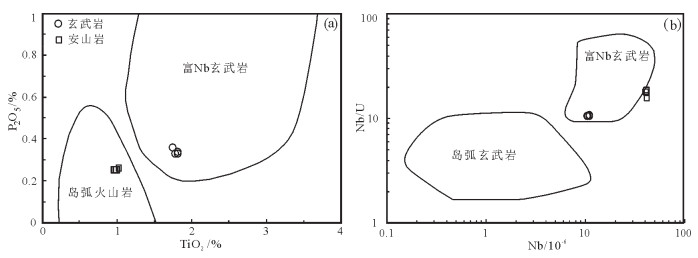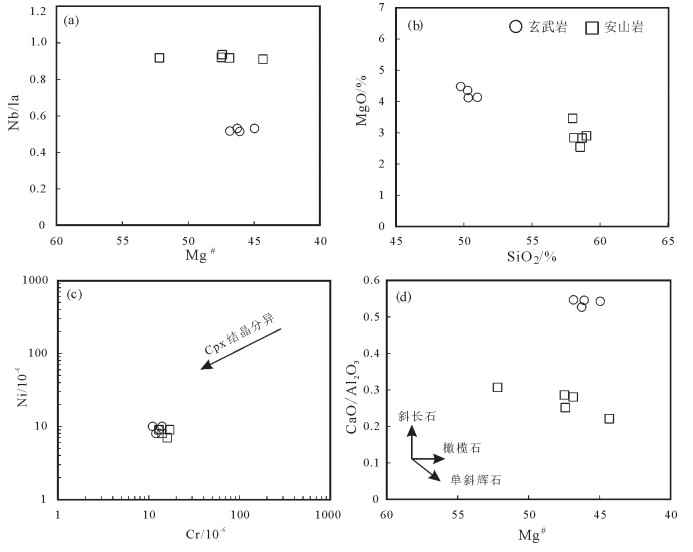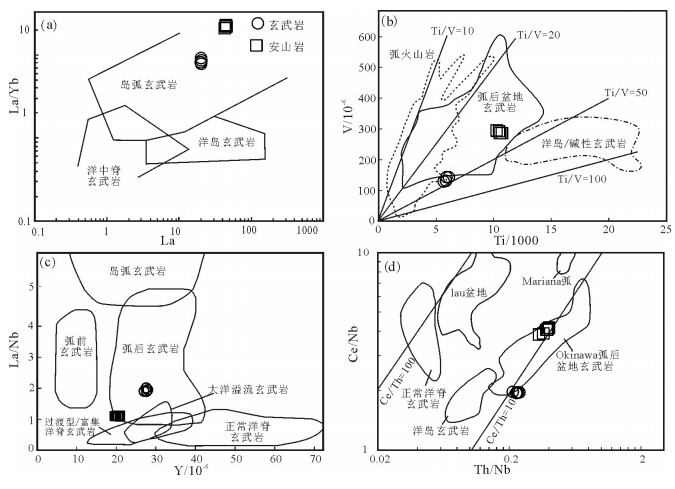The discovery of Nb-rich volcanic rock of the Qushenla Formation in Yema area of the western segment of Bangong Co-Nujiang suture in Tibet and its implications
-
摘要:
以班公湖-怒江缝合带西段的去申拉组玄武岩和安山岩为研究对象,进行了岩石锆石测年和地球化学研究。测年结果显示,安山岩形成于108.5±1.5Ma,属于早白垩世晚期。岩石地球化学特征表明,野马去申拉组玄武岩Nb含量为10.5×10-6~11.1×10-6,Al2O3含量为17.63%~17.96%(平均值17.74%),属于富Nb高铝玄武岩,为中钾钙碱性系列;安山岩属于高钾钙碱性系列岩石。野马火山岩轻、重稀土元素分异明显,其中玄武岩稀土元素总量为119.20×10-6~120.49×10-6,(La/Yb)N值为5.17~5.53;安山岩稀土元素总量为179.97×10-6~184.75×10-6,(La/Yb)N值为13.83~15.12;二者在微量元素上表现出不同程度的富集轻稀土元素和大离子亲石元素,Nb、Ta、Ti等高场强元素相对亏损,具低Cr、Ni,高Sr、Nb、Zr含量,发育岛弧火山岩相关特征。其岩浆源区受俯冲流体的影响较大,后经历了不同程度的铁镁矿物的结晶分离作用。综合分析认为,野马去申拉组火山岩可能形成于弧后盆地构造环境下,是班公湖-怒江特提斯洋岩石圈南向俯冲过程中板片断离导致软流圈地幔上涌,诱发弧后拉张背景下的直接岩浆响应。
Abstract:The volcanic rocks from Qushenla Formation in Yema area is located in the west segment of Bangong Co-Nujiang suture zone, in reverse fault contact with the diabase slice of Bangong Co-Nujiang opiolite melange belt in the north. In this paper, detailed LA-ICP-MS zircon U-Pb dating geochronological and element geochemical studies were carried out for the basalt and andesite in the Qushenla Formation. The U-Pb dating of zircon from andesite yielded a weighted average age of 108.5±1.5Ma, indicating that the andesites were formed at the middle-late stages of Early Cretaceous. Lithogeochemical characteristics show that the Nb-rich basalts in Yema area are characterized by obvious enrichment of Nb and Al2O3, with the values of Nb being 10.5×10-6~11.1×10-6 and Al2O3 being 17.63%~17.96%, averaging 17.74%, suggesting Nb-rich, high-alumina basalt of calc alkaline series. The andesites belong to high-K calc alkaline series. All the volcanic rocks in Yama area are characterized by enriched LREE and relatively depleted HREE. The total REE of basalts are 119.20×10-6~120.49×10-6, with (La/Yb)N from 5.17 to 5.53, and the ∑REE of andesites are 179.97×10-6~184.75×10-6 and their (La/Yb)N range from 13.83 to 15.12. On primitive mantle-normalized trace element diagrams, the basalts and andesite display different degrees of enrichment of LIFEs (e.g., Rb, U, K), relative depletion of HFSE (Nb, Ta, Ti) with high content of Sr, Nb, Zr but low content of Cr, Ni, similar to features of island arc rocks. The magma source region was mainly influenced by the subduction fluid and underwent different degrees of fractionation crystallization of femic minerals with uplifting. A comprehensive study shows that the basalt and andesite of Qushenla Formation in Yema area were probably formed in the backarc tectonic rocks, which might have been the direct magma response to slab break-off caused by asthenosphere upwelling back-arcextension during the southward subduction of Bangong Co-Nujiang Tethyan Ocean at the late stage of Early Cretaceous.
-
Keywords:
- Nb-rich basalt /
- andesite /
- back-arc basin /
- Qushenla Formation /
- Bangong Co-Nujiang suture zone
-
西藏神公地区位于冈底斯构造带南部,分布有大量的钙碱性系列火成岩,形成于晚侏罗世—古近纪,其中以林子宗群中酸性火成岩为主体岩系,该套岩系自下而上划分为典中组、年波组、帕那组。以往研究表明[1-3],该套火成岩系的形成与新特提斯洋俯冲闭合及随后的印度-欧亚大陆碰撞事件关系密切,蕴含丰富的陆块碰撞的动力学信息,因此得到广泛的关注。
近年来,典中组火成岩的喷发时间及形成环境的研究一直是印度-欧亚板块碰撞活动研究的热点。周肃等[4]利用Ar-Ar定年得到林周盆地典中组火成岩的年龄值为64.4~60.5Ma;聂国永等[5]通过堆龙德庆县马区典中组底部底砾岩的研究认为,印度-欧亚大陆的碰撞时限约为65Ma;胡新伟等[6]测得措勤地区典中组火成岩的K-Ar同位素年龄值为63.9Ma,且稀土元素特征表现为轻稀土元素富集,负Eu异常,微量元素Rb、Ba、K、Th、U富集,Ti、P、Sr、Ta亏损,并认为典中组火成岩源于俯冲带幔源基性岩浆与陆壳重熔酸性岩浆的不同比例混合;梁银平等[7]利用U-Pb测年得到朱诺地区典中组上部流纹质凝灰岩的年龄值为64.8±1.6Ma,并指出典中组火成岩具有岛弧火成岩的特点。
本文在前人研究成果的基础上,对冈底斯构造带神公地区典中组顶底中酸性火成岩进行了锆石U-Pb同位素定年及主量、稀土和微量元素测试,进一步厘定该地区典中组火成岩的形成时限,同时探讨其构造环境意义,为青藏高原的构造演化提供新的依据。
1. 区域地质背景
冈底斯构造带位于青藏高原南部,呈近东西向展布,长约2000km,北以班公湖-怒江结合带为界,南以印度河-雅鲁藏布江缝合带为界,构成南北宽100~300km的带状岩浆岩分布区,指示了裂隙式喷发的特征[8]。研究区位于冈底斯构造带的次一级构造单元隆格尔-工布江达弧背断隆带的神公地区(图 1),区内白垩纪—古近纪中酸性火成岩广泛分布,记录了印度-欧亚板块碰撞过程的岩浆活动信息。晚侏罗世末期,欧亚陆块南缘的特提斯洋开始向北俯冲消减,至晚白垩世,俯冲消减持续进行,海水下降明显,沉积了一套海相-陆相红色砂泥岩,至晚白垩世末期,特提斯洋俯冲消减速度加快,最终形成岛弧背景下的火山喷发活动。
典中组中酸性火成岩厚度为635.7~1200m,岩石类型主要包括安山岩、流纹岩、英安岩,以及相应的火山碎屑岩,另少见火山集块岩,与下伏晚白垩世设兴组紫红色泥砂岩之间呈角度不整合接触关系,底部局部可见底砾岩,上部与年波组火山-沉积岩系呈平行不整合接触。
2. 样品及实验条件
研究区典中组火成岩出露面积广,主要为一套中酸性火成岩,岩石类型主要有英安岩、安山岩、流纹岩,以及相应的火山碎屑岩。另外,在底部可见基性玄武安山岩。对主要岩石类型简要描述如下。
英安岩:灰绿色,斑状结构,块状构造,斑晶含量约25%,几乎都由石英组成,偶见斜长石斑晶,基质含量约75%,主要由隐晶长英质成分组成,部分硅化重结晶形成细粒集合体状石英和少量鳞片状绢云母,集合体状石英多呈完全长条状(图 2-a、d)。
玄武安山岩:浅灰绿色,斑状、聚斑结构,基质为玻基交织结构,块状构造。主要由斑晶和基质组成。斑晶:斜长石占10%~20%,呈自形板状晶及聚斑产出,轻微碳酸盐化,具环带结构,以中性斜长石为主;基质占70%~80%,由微细晶斜长石和玻璃质、铁质、磁铁矿和少量橄榄石组成,组成玻基交织结构,橄榄石呈半自形粒状细晶产出(图 2-b)。
安山岩:浅灰色,斑状结构,基质具微晶结构,块状构造。主要由斑晶、基质组成。斑晶:斜长石微晶,占25%~30%,半自形柱状,碎裂纹发育,有隐约的环带构造,偶见角闪石,半自形柱状;基质以斜长石微晶为主,占60%~65%,呈定向-半定向排列,有强绿帘石化、绿泥石化,少见微小的杏仁体,由绿泥石、硅质充填(图 2-c)。
以神公地区典中组火成岩为研究对象,采集火成岩样品12件。选取顶底的DPM013TW19(英安岩)、DPM013TW25(玄武质安山岩)样品进行LAICP-MS锆石U-Pb同位素测试,测试结果见表 1。同时,对10件样品分别进行主量、微量和稀土元素测试,测试结果见表 2。
表 1 典中组火成岩LA-ICP-MS锆石U-Th-Pb测试分析结果Table 1. LA-ICP-MS zircon U-Th-Pb data of Dianzhong Formation igneous rocks测点号 Pb Th U Th/U 同位素比值 锆石年龄/Ma 含量/10-6 207Pb/235U 1σ 206Pb/238U 1σ 207Pb/235U 1σ 206Pb/238U 1σ DMP013TW25玄武安山岩 1 2.44 186 183 1.01 0.0726 0.0064 0.0101 0.0002 71.2 6.1 64.7 1.4 2 3.15 252 252 1.00 0.0693 0.0033 0.0097 0.0001 68.0 3.1 62.2 0.9 3 2.01 166 161 1.03 0.0687 0.0035 0.0098 0.0001 67.5 3.3 62.9 0.8 4 2.75 240 201 1.20 0.0687 0.0042 0.0101 0.0002 67.4 4.0 64.8 1.1 5 2.59 245 195 1.26 0.0667 0.0036 0.0100 0.0001 65.5 3.4 64.3 0.8 6 3.61 327 265 1.23 0.0698 0.0038 0.0104 0.0001 68.5 3.6 66.7 0.9 7 2.60 223 192 1.16 0.0677 0.0035 0.0106 0.0001 66.5 3.4 67.7 0.9 8 2.35 216 171 1.26 0.0703 0.0043 0.0105 0.0002 69.0 4.1 67.3 1.0 9 2.37 229 178 1.29 0.0639 0.0029 0.0100 0.0001 62.9 2.7 64.2 0.7 10 2.44 208 185 1.12 0.0679 0.0030 0.0102 0.0001 66.7 2.9 65.6 0.7 11 4.89 326 395 0.83 0.0666 0.0019 0.0102 0.0001 65.5 1.8 65.5 0.5 12 2.60 213 198 1.08 0.0656 0.0026 0.0103 0.0001 64.5 2.5 66.2 0.7 13 2.21 177 169 1.05 0.0697 0.0032 0.0104 0.0001 68.4 3.1 66.4 0.8 14 2.55 205 199 1.03 0.0673 0.0029 0.0102 0.0001 66.1 2.8 65.7 0.7 15 1.82 140 143 0.98 0.0671 0.0034 0.0102 0.0001 66.0 3.2 65.6 0.8 DMP013TW19英安岩 1 11.63 856 1074 0.80 0.0591 0.0015 0.0092 0.0001 58.3 1.5 59.0 0.5 2 18.64 1742 1726 1.01 0.0591 0.0012 0.0088 0.0001 58.3 1.2 56.3 0.4 3 15.45 1287 1420 0.91 0.0605 0.0013 0.0088 0.0001 59.6 1.3 56.2 0.4 4 19.06 2034 1686 1.21 0.0586 0.0012 0.0089 0.0001 57.9 1.2 57.2 0.4 5 19.15 1776 1739 1.02 0.0596 0.0012 0.0089 0.0001 58.7 1.1 57.4 0.4 6 13.55 1345 1203 1.12 0.0609 0.0015 0.0092 0.0001 60.1 1.5 58.9 0.5 7 17.80 1486 1674 0.89 0.0576 0.0011 0.0089 0.0001 56.9 1.1 56.9 0.4 10 20.10 1553 1863 0.83 0.0623 0.0012 0.0090 0.0001 61.4 1.2 57.9 0.4 11 29.39 3774 2441 1.55 0.0594 0.0010 0.0088 0.0001 58.6 1.0 56.7 0.4 12 19.98 1744 1832 0.95 0.0600 0.0012 0.0089 0.0001 59.1 1.1 57.2 0.4 13 20.97 2026 1922 1.05 0.0574 0.0011 0.0088 0.0001 56.6 1.1 56.4 0.4 14 13.62 975 1251 0.78 0.0614 0.0015 0.0092 0.0001 60.5 1.4 59.0 0.5 16 18.79 1730 1679 1.03 0.0609 0.0013 0.0090 0.0001 60.0 1.2 57.6 0.4 18 14.83 830 1419 0.59 0.0604 0.0014 0.0092 0.0001 59.5 1.3 59.2 0.5 19 21.17 2025 1863 1.09 0.0572 0.0012 0.0091 0.0001 56.5 1.1 58.2 0.4 20 23.78 1976 2136 0.93 0.0597 0.0011 0.0090 0.0001 58.9 1.0 57.6 0.4 表 2 典中组火成岩主量、微量、稀土元素测试分析结果Table 2. Analytical results of major elements, trace elements and REE in Dianzhong Formation igneous rocks样品号 XT-01 XT-02 XT-03 XT-04 XT-05 XT-06 XT-07 XT-08 XT-09 XT-10 岩性 安山岩 流纹岩 安山岩 安山岩 安山岩 英安岩 英安岩 流纹岩 流纹岩 粗面岩 SiO2 60.58 73.97 59.57 60.72 61.36 69.08 68.45 74.13 70.28 66.57 TiO2 0.65 0.12 0.99 0.85 0.92 0.63 0.53 0.27 0.27 0.31 Al2O3 15.12 13.88 16.34 16.00 15.49 15.02 14.42 13.17 14.73 15.79 CaO 4.52 0.42 3.71 4.29 4.38 0.77 2.17 0.32 1.56 1.90 Fe2O3 2.16 0.22 5.03 3.54 3.94 2.59 0.80 1.69 1.28 1.34 FeO 3.14 1.39 2.04 2.64 2.48 1.20 3.88 0.85 1.10 2.54 Na2O 3.03 2.53 4.12 3.41 3.32 2.83 3.11 2.60 3.67 3.30 K2O 2.30 5.43 2.12 3.15 2.21 4.89 4.18 5.67 5.77 5.56 P2O5 0.43 0.20 0.25 0.25 0.25 0.19 0.14 0.11 0.08 0.11 H2O+ 1.95 1.09 0.01 1.79 0.01 2.22 1.34 0.78 0.59 0.98 CO2 0.26 0.13 0.21 0.62 0.10 0.18 0.04 0.09 0.26 0.13 总量 94.16 99.37 94.39 97.25 94.47 99.59 99.06 99.68 99.58 98.52 Na2O+K2O 5.34 7.95 6.23 6.56 5.53 7.73 7.29 8.26 9.44 8.87 K2O/Na2O 0.76 2.15 0.51 0.92 0.67 1.73 1.34 2.18 1.57 1.68 La 89.63 19.36 37.91 49.87 35.13 88.71 94.02 120.23 81.92 107.53 Ce 122.40 33.55 75.87 80.52 67.37 130.86 132.86 152.44 101.00 141.84 Pr 16.70 4.28 8.22 10.77 7.83 13.60 17.14 17.58 12.75 18.05 Nd 61.67 15.06 30.74 40.02 32.18 43.93 61.43 53.50 42.44 62.21 Sm 10.60 3.13 6.06 6.85 5.86 6.52 10.30 7.83 6.63 9.83 Eu 2.11 0.63 1.54 1.56 1.46 1.31 2.10 0.94 1.10 1.73 Gd 7.87 2.78 5.76 6.17 4.95 5.79 8.95 6.68 4.97 7.23 Tb 1.19 0.55 0.92 1.06 0.86 0.95 1.55 1.12 0.76 1.06 Dy 5.30 2.45 5.22 5.22 4.97 4.50 7.72 5.57 3.41 4.62 Ho 0.96 0.45 0.98 1.06 0.99 0.86 1.49 1.11 0.65 0.85 Er 2.62 1.10 3.06 2.91 2.94 2.52 4.21 3.19 1.86 2.47 Tm 0.42 0.21 0.49 0.49 0.46 0.42 0.69 0.54 0.31 0.41 Yb 2.56 1.08 3.33 3.13 3.07 2.61 4.12 3.41 1.94 2.74 Lu 0.38 0.16 0.48 0.43 0.44 0.37 0.56 0.48 0.27 0.38 ƩREE 324.44 84.78 180.57 210.07 168.52 302.95 347.13 374.62 260.01 360.97 LREE/HREE 14.23 8.67 7.92 9.26 8.02 15.81 10.86 15.95 17.35 17.25 δEu 0.74 0.70 0.86 0.79 0.89 0.70 0.72 0.42 0.61 0.65 (La/Yb)N 20.75 10.64 6.77 9.46 6.80 20.21 13.56 20.96 25.13 23.30 (La/Sm)N 5.28 3.87 3.91 4.55 3.75 8.50 5.70 9.60 7.72 6.84 (Gd/Yb)N 1.88 1.58 1.06 1.21 0.99 1.36 1.33 1.20 1.58 1.62 Rb 258.23 347.34 87.21 129.19 53.23 284.46 166.71 381.11 389.52 340.45 Th 40.58 17.22 14.53 14.82 12.60 45.05 23.16 79.09 65.02 55.65 U 9.01 5.68 3.61 2.73 3.52 4.77 2.58 2.81 14.78 13.62 Hf 7.10 2.83 5.02 5.78 5.60 7.89 12.66 6.89 6.73 8.37 Zr 179.44 61.98 153.13 210.97 126.79 266.02 484.43 188.95 202.28 186.32 Sr 1091.50 54.44 356.04 397.59 441.04 220.30 203.97 87.84 422.45 723.20 V 106.22 8.84 113.52 89.26 124.10 51.02 28.05 18.57 25.30 52.23 Pb 35.38 76.15 25.29 32.58 20.35 64.26 44.50 51.07 60.49 51.39 Co 19.04 0.85 15.13 8.92 17.64 6.61 4.47 2.77 2.43 4.36 Y 30.87 12.32 28.41 29.67 28.76 24.52 49.16 33.31 20.14 28.22 Nb 13.95 12.95 11.03 10.38 11.25 8.14 13.81 17.79 7.26 24.65 Tb 0.49 0.55 1.13 1.06 0.93 0.95 1.55 1.12 0.76 0.73 Zn 58.63 24.50 96.54 82.98 60.73 73.77 95.64 30.56 45.30 71.43 Sb 0.84 1.36 0.53 0.47 0.64 1.15 0.32 0.50 0.75 1.35 Ta 0.92 0.67 0.76 0.73 0.71 0.65 1.01 1.24 0.58 1.43 Rb/Sr 0.24 6.38 0.24 0.32 0.12 1.29 0.82 4.34 0.92 0.47 Nb/Ta 15.16 19.33 14.51 14.21 15.84 12.52 13.67 14.35 12.51 17.23 注:主量元素含量单位为%,微量和稀土元素含量单位为10-6 在中国地质大学地质过程与矿产资源国家重点实验室使用激光剥蚀等离子体质谱仪分析完成锆石U-Pb同位素测试,激光束直径32μm,以氦为载气,以标准锆石91500为外标进行同位素分馏校正,数据采用ICPMSDataCal10.2软件处理,详细的实验操作见Liu等[9]。主量、微量、稀土元素均在西南冶金地质测试中心完成,其中主量元素采用XRF法测定,微量、稀土元素采用ICP-MS法测定。
3. 锆石U-Pb同位素年龄
典中组底部和顶部玄武安山岩样品DPM013TW25和英安岩样品DPM013TW19的锆石特征相似,均呈无色透明、长柱状或短柱状,且自形程度较高,在CL图像上可见明显岩浆成因特征的振荡生长环带(图 3)。另外,底部样品DPM013TW25锆石的Th/U值为0.83~1.29,平均值为1.04;顶部样品DPM013TW19锆石的Th/U值为0.59~1.55,平均值为0.79(表 1),也反映了岩浆成因特征[10]。
测试结果表明,底部样品(DPM013TW25)15个测点的206Pb/238U年龄值分布于62.2~67.7Ma之间,在U-Pb谐和图(图 4-a)上,这些测点均落于谐和线上或其附近,给出的206Pb/238U年龄加权平均值为65.37±0.58Ma(2σ;MSWD=1.7),指示了典中组底部火成岩的形成时代,代表了典中组岩浆活动的起始时间,同时,也代表了林子宗火成岩最初的形成年龄。顶部样品(DPM013TW19)16个测点的206Pb/238U年龄值分布于56.2~59.2Ma之间,在UPb谐和图(图 4-b)上,这些测点均落于谐和线上或附近,给出的206Pb/238U年龄加权平均值为57.42±0.20Ma(2σ;MSWD=4.9),指示了典中组顶部火成岩的形成时代,同时也代表了典中组岩浆活动的终止时间。
4. 地球化学特征
本次研究选取研究区典中组10件火成岩样品分别进行主量、微量和稀土元素分析,测试结果见表 2。
4.1 主量元素
主量元素测试结果表明,典中组火成岩样品的SiO2含量为60.58%~74.13%,平均值为66.47%,Al2O3含量为13.17% ~15.79%,平均值为14.99%,全碱(Na2O+K2O)含量为5.35%~9.44%,平均值为7.32%,里特曼组合指数为1.63~3.34,平均值为2.33,属钙碱性系列岩石。在TAS图解(图 5-a)中,典中组火成岩样品点落入中酸性火成岩区域,位于亚碱性岩石范围;在Na2O-K2O图解(图 5-b)中,除2个样品外,其余样品点均落在钾玄岩范围。K2O/Na2O值介于0.51~2.18之间,平均值为1.35,而钾玄岩的出现被认为是大洋岩石圈俯冲结束,陆内汇聚开始的重要标志[7, 13]。总体看,研究区典中组火成岩样品与杨辉等[14]报道的西藏马乡地区和胡新伟等[6]报道的西藏措勤地区典中组火成岩类似,以钙碱性系列岩石为主,显示富碱、富硅的特征。
4.2 稀土元素
稀土元素因地球化学性质相似,在地质作用过程中往往表现为相似的地球化学行为,具有良好的成岩指示信息,而广泛应用于成岩流体性质及成岩环境分析的研究中[15]。研究区典中组10个火成岩样品的稀土元素分析结果如表 2所示。稀土元素总量(∑REE)普遍偏高,除1个样品较低(84.78×10-6)外,其余样品的∑REE值多为168.52×10-6~374.62×10-6,平均值为281.03×10-6;轻、重稀土元素比值偏大,在7.92~17.35之间,平均值为12.53,(La/Yb)N值分布在6.77~25.13之间,平均值为15.76,反映轻重稀土元素经历了较强的分馏作用,呈现轻稀土元素富集、重稀土元素相对亏损的特征。另外,(La/Sm)N值在3.75~9.60之间,(Gd/Yb)N值在0.99~1.88之间,反映LREE(轻稀土元素)相对HREE(重稀土元素)经历了更高程度的分馏作用。
从稀土元素球粒陨石标准化配分图解(图 6-a)可以看出,研究区典中组火成岩稀土元素配分曲线表现为轻稀土元素富集、重稀土元素相对亏损的右倾形态。另外,Eu具明显的负异常,δEu值分布在0.42~0.89之间,平均值为0.71,可能与岩浆结晶分异造成的斜长石析出有关[17]。典中组火成岩样品的稀土元素组成特征与区内同时期的钙碱性中酸性火成岩类似。
![]() 图 6 典中组火成岩稀土元素配分模式(a)和微量元素蛛网图(b)(原始地幔数据据参考文献[16])Figure 6. REE patterns (a) and primitive mantle-normalized trace element patterns (b) of Dianzhong Formation igneous rocks
图 6 典中组火成岩稀土元素配分模式(a)和微量元素蛛网图(b)(原始地幔数据据参考文献[16])Figure 6. REE patterns (a) and primitive mantle-normalized trace element patterns (b) of Dianzhong Formation igneous rocks4.3 微量元素
研究区典中组10组火成岩微量元素测试结果见表 2,Sr、Zr、Hf、Ce等元素含量普遍偏高,且接近于贾建称等[18]测定的林子宗群火成岩微量元素值。Rb/Sr值在0.12~6.38之间,平均值为1.52,高于陆壳均质0.24[8],另外,Nb/Ta值在12.51~19.33之间,平均值为14.94,介于地幔标志值17.5[16]和地壳标志值11~12[19]之间,说明典中组火成岩的岩浆来源和地幔、地壳有关,可能为二者以不同比例混合的产物。典中组火成岩的微量元素原始地幔标准化蛛网图(图 6-b)与前人的研究结果相似[6, 14],表现为明显的“峰谷”特征,即Rb、Th、U、Pb等大离子亲石元素富集,Nb、Ta、Ti亏损,并呈“槽谷”形态。Nb、Ta、Ti的槽谷形态可能与俯冲碰撞环境有关[8, 20],且明显的Ti谷也说明有陆壳物质的混入。因此认为,典中组火成岩是在俯冲碰撞背景下,幔源和壳源岩浆以不同比例混合形成的。
5. 讨论
通过对典中组顶底岩浆锆石U-Pb同位素定年可知,典中组岩浆活动发生在65.37±0.58~57.42± 0.20Ma之间,与冈底斯构造带其他地区典中组火成岩测得的年龄值基本一致,表明典中组岩浆活动开始于晚白垩世,结束于古新世末,同时进一步确认林子宗群火成岩的形成时期为晚白垩世,与印度-欧亚板块开始发生碰撞的时间65/70Ma基本吻合[8]。主量元素分析表明,研究区典中组火成岩样品的里特曼组合指数平均值为2.33,属钙碱性系列岩石,TAS图解中,典中组火成岩样品基本分布在中酸性火成岩区域,位于亚碱性岩石范围,稀土元素组成特征也说明研究区典中组火成岩属钙碱性中酸性火成岩范畴,同时,K2O/Na2O值较高,平均值为1.35;在Na2O-K2O图解中,典中组火成岩样品基本落在钾玄岩范围,指示了俯冲造山的构造背景。结合前人的锶、氧同位素研究结果[6],典中组火成岩为壳源岩浆和幔源岩浆以不同比例混合的产物。大离子亲石元素Rb、Th、U、Pb的富集,Nb、Ta、Ti等元素的亏损进一步说明俯冲背景下岩浆中陆壳物质的混入。前人[6, 17]对冈底斯地区典中组火成岩形成的构造环境分析结果表明,典中组火成岩在相关图解中落入火山弧区域,指示其形成于俯冲造山的构造环境,且与古新世喜马拉雅特提斯洋壳向北大规模俯冲产生的远程效应有关。结合区域地质背景,认为典中组火成岩形成于印度-欧亚板块碰撞期间的白垩纪末—古近纪初,为俯冲构造背景下的造山带环境中幔源和壳源岩浆以不同比例混合的产物。
6. 结论
(1)冈底斯构造带神公地区典中组底部火成岩样品DPM013TW25锆石U- Pb年龄为65.37 ± 0.58Ma,顶部火成岩样品DPM013TW19锆石U-Pb年龄为57.42±0.20Ma,指示典中组火成岩形成的年龄时限为65.37~57.42Ma,限定典中组火山活动发生在白垩纪末—古近纪初,也指示了林子宗群火成岩最开始形成的时期,同时也限定了林子宗群火成岩与下伏地层之间不整合接触面的形成时间。
(2)典中组火成岩主要为一套钙碱性系列中酸性火成岩,与区内同时期火成岩类似,Rb、Th、U、Pb等大离子亲石元素富集,Nb、Ta、Ti等因亏损呈现“槽谷”形态,Rb/Sr值在0.12~6.38之间,Nb/Ta值在12.51~19.33之间,表明典中组火成岩中含有大量陆壳成分,为俯冲碰撞背景下的岛弧环境中幔源岩浆和壳源岩浆混合的产物,可能与新特提斯洋关闭引起的洋壳俯冲作用有关。
致谢: 感谢野外工作过程中四川地调院西藏昂龙岗日1:5万区域地质调查项目组其他成员的热心帮助;感谢审稿专家提出的宝贵修改意见和建议。 -
图 6 去申拉组火山岩稀土元素球粒陨石标准化配分图(a)和微量元素原始地幔标准化蛛网图(b)
(标准化数据据参考文献[21])
Figure 6. Chondrite-normalized REE patterns (a) of primitive mantle-normalized trace element patterns (b) for volcanic rocks of Qushenla Formation
表 1 野马去申拉组安山岩LA-ICP-MS锆石Th-U-Pb分析结果
Table 1 LA-ICP-MS zircon U-Th-Pb analytical results of andesite from Qushenla Formation, Yema area
测点号 元素含量/10-6 238U/232Th 207Pb/206Pb 207Pb/235U 206Pb/238U 207Pb/206Pb 207Pb/235U 206Pb/238U PbTotal 232Th 238U 比值 比值 ±1σ 比值 ±1σ 比值 ±1σ 年龄/Ma ±1σ 年龄/Ma ±1σ 年龄/Ma ±1σ PM4N1-03 16.9 1404 557 0.42 0.0512 0.0027 0.1218 0.0063 0.0173 0.0003 250 124 117 6 110 2 PM4N1-04 2.91 160 116 0.76 0.0475 0.0054 0.1056 0.0099 0.0165 0.0004 72 248 102 9 105 3 PM4N1-05 5.21 318 209 0.69 0.0549 0.0048 0.1236 0.0098 0.0166 0.0004 409 192 118 9 106 2 PM4N1-06 3.30 174 136 0.83 0.0502 0.0050 0.1136 0.0097 0.0174 0.0004 211 206 109 9 111 3 PM4N1-08 4.74 291 186 0.68 0.0491 0.0041 0.1144 0.0090 0.0170 0.0004 154 185 110 8 109 2 PM4N1-09 8.60 617 299 0.51 0.0440 0.0036 0.1051 0.0082 0.0175 0.0002 174 159 102 8 112 2 PM4N1-12 20.0 1892 601 0.33 0.0498 0.0029 0.1136 0.0065 0.0165 0.0002 183 139 109 6 105 2 PM4N1-13 3.56 176 151 0.90 0.0516 0.0053 0.1134 0.0103 0.0163 0.0004 333 237 109 9 104 2 PM4N1-14 14.6 1133 508 0.47 0.0487 0.0027 0.1107 0.0059 0.0164 0.0003 132 130 107 5 105 2 PM4N1-15 8.72 566 315 0.62 0.0465 0.0037 0.1068 0.0076 0.0172 0.0003 33 172 103 7 110 2 PM4N1-16 5.66 329 228 0.73 0.0560 0.0044 0.1300 0.0096 0.0168 0.0004 454 144 124 9 107 2 PM4N1-17 4.18 254 156 0.65 0.0537 0.0051 0.1224 0.0092 0.0171 0.0004 361 215 117 8 109 3 PM4N1-18 19.7 1620 610 0.42 0.0500 0.0027 0.1159 0.0062 0.0168 0.0003 195 131 111 6 108 2 PM4N1-19 5.23 282 206 0.78 0.0535 0.0047 0.1179 0.0090 0.0166 0.0004 350 169 113 8 106 2 PM4N1-20 103 10565 2471 0.25 0.0506 0.0015 0.1248 0.0037 0.0177 0.0002 233 67 119 3 113 1 PM4N1-21 2.15 104 85.7 0.86 0.0537 0.0064 0.1212 0.0118 0.0180 0.0006 361 264 116 11 115 4 PM4N1-22 2.17 115 85.8 0.78 0.0491 0.0072 0.1061 0.0139 0.0169 0.0006 154 311 102 13 108 3 PM4N1-23 11.56 882 413 0.51 0.0544 0.0038 0.1230 0.0080 0.0164 0.0003 387 159 118 7 105 2 PM4N1-24 6.79 451 261 0.60 0.0470 0.0039 0.1096 0.0088 0.0170 0.0003 50 189 106 8 108 2 表 2 野马玄武岩和安山岩主量、微量和稀土元素组成
Table 2 Major elements, trace elements and REE composition of the basalt and andesite, Yema area
岩性 玄武岩 安山岩 样号 PM4ZH1 PM4ZH2 PM4ZH3 PM4ZH4 PM4ZH5 PM4ZH6 PM4ZH7 PM4ZH8 PM4ZH9 Al2O3 17.96 17.66 17.72 17.63 18.34 17.2 17.05 17.08 17.06 BaO 0.05 0.04 0.03 0.03 0.07 0.06 0.07 0.07 0.08 CaO 9.82 9.3 9.67 9.57 4.05 4.92 4.78 5.24 4.29 TFe2O3 10.07 9.5 10.08 9.99 6.32 6.2 6.38 6.28 6.37 K2O 0.91 1.11 1.21 0.84 2.68 2.42 2.74 2.28 2.7 MgO 4.48 4.13 4.35 4.12 2.54 2.83 2.84 3.46 2.9 MnO 0.16 0.17 0.21 0.2 0.14 0.15 0.16 0.2 0.17 Na2O 3.37 3.58 3.25 3.53 5.59 4.81 4.85 4.48 5.24 P2O5 0.34 0.36 0.33 0.33 0.25 0.25 0.26 0.26 0.25 SiO2 49.76 50.99 50.27 50.32 58.55 58.69 58.09 57.99 59.01 TiO2 1.82 1.75 1.82 1.78 0.98 0.97 1.02 1.02 1 FeO 2.77 2.61 2.99 2.8 1.74 2.25 2.19 2.3 2.14 烧失量 1.4 1.33 1.02 1.31 1.1 1.6 1.65 1.47 1.46 总计 100.14 99.92 99.96 99.65 100.61 100.1 99.89 99.83 100.53 Rb 14.7 18.9 26.6 15.7 72.3 68.1 84.4 65.1 79.9 K 1310 1100 1600 1650 1470 1460 1650 1020 1371.111 Ba 361 339 280 292 646 562 649 583 741 Th 3.96 4.02 3.93 3.92 9.62 9.59 9.31 9.47 9.02 U 1.01 1.04 0.98 1.02 2.21 2.28 2.25 2.63 2.31 Nb 10.7 11.1 10.5 11 41.9 41.7 41 41.6 40.9 Sr 604 638 568 620 631 628 676 687 708 Nd 23.3 23.5 23.3 23 27.8 27.2 27.9 28 27.6 P 1450 1510 1470 1460 1100 1080 1120 1110 1070 Zr 139 143 139 139 247 246 241 243 240 Hf 3.9 3.9 3.8 3.7 6 5.8 5.6 5.8 5.5 Sm 5.58 5.71 5.73 5.58 5.18 4.94 5.1 5 5.03 Ti 10600 10300 10700 10500 5900 5800 6100 6000 5800 Ta 0.7 0.7 0.7 0.7 2.6 2.6 2.6 2.5 2.4 La 20.7 20.9 20.4 20.7 46 45.3 44.7 45.3 43.7 Ce 43.3 43.7 43.2 43.3 81.1 80.7 78.9 80.3 79.4 Pr 5.65 5.7 5.7 5.66 8.59 8.43 8.47 8.53 8.41 Nd 23.3 23.5 23.3 23 27.8 27.2 27.9 28 27.6 Sm 5.58 5.71 5.73 5.58 5.18 4.94 5.1 5 5.03 Eu 1.8 1.85 1.81 1.88 1.56 1.51 1.51 1.49 1.54 Gd 5.85 5.8 5.91 5.75 4.27 4.1 4.2 4.24 4.39 Tb 0.91 0.89 0.92 0.86 0.67 0.62 0.63 0.64 0.64 Dy 5.31 5.23 5.34 5.2 3.84 3.6 3.67 3.65 3.73 Ho 1.03 1.06 1.04 1.04 0.73 0.68 0.71 0.7 0.72 Er 2.9 2.82 2.91 2.85 2.23 2.02 2.17 2.07 2.07 Tm 0.4 0.41 0.41 0.41 0.31 0.29 0.3 0.3 0.3 Yb 2.7 2.55 2.56 2.61 2.15 2.02 2.08 2.02 2.13 Lu 0.37 0.37 0.38 0.36 0.32 0.3 0.31 0.31 0.31 U 1.01 1.04 0.98 1.02 2.21 2.28 2.25 2.63 2.31 注:主量元素含量单位为%,微量和稀土元素为10-6 -
潘桂堂, 莫宣学, 侯增谦, 等.冈底斯造山带的时空结构及演化[J].岩石学报, 2006, 22(3):521-533. http://d.old.wanfangdata.com.cn/Periodical/ysxb98200603001 耿全如, 潘桂堂, 王立全, 等.班公湖-怒江、羌塘地块特提斯演化与成矿地质背景[J].地质通报, 2011, 30(8):1261-1274. http://dzhtb.cgs.cn/gbc/ch/reader/view_abstract.aspx?file_no=20110813&flag=1 朱弟成, 潘桂堂, 莫宣学, 等.冈底斯中北部晚侏罗世-早白垩世地球动力学环境:火山岩约束[J].岩石学报, 2006, 22(3):534-546. http://d.old.wanfangdata.com.cn/Periodical/ysxb98200603002 朱弟成, 莫宣学, 赵志丹, 等.西藏冈底斯带措勤地区则弄群火山岩锆石U-Pb年代学格架及构造意义[J].岩石学报, 2008, 24(3):401-412. http://d.old.wanfangdata.com.cn/Periodical/ysxb98200803001 李金祥, 李光明, 秦克章, 等.班公湖带多不杂富金斑岩铜矿床斑岩-火山岩的地球化学特征与时代:对成矿构造背景的制约[J].岩石学报, 2008, 24(3):531-543. http://d.old.wanfangdata.com.cn/Periodical/ysxb98200803013 康志强, 许继峰, 王保弟, 等.拉萨地块北部白垩纪多尼组火山岩的地球化学:形成的构造环境[J].地球科学-中国地质大学学报, 2009, 34(1):89-104. doi: 10.3321/j.issn:1000-2383.2009.01.009 康志强, 许继峰, 王保弟, 等.拉萨地块北部去申拉组火山岩:班公湖-怒江特提斯洋南向俯冲的产物?[J].岩石学报, 2010, 26(10):3106-16. http://d.old.wanfangdata.com.cn/Periodical/ysxb98201010022 Sui Q L, Wang Q, Zhu D C, et al. Compositional diversity of ca. 110Ma magmatism in the northern Lhasa Terrane, Tibet:Implications for the magmatic origin and crustal growth in a continent-continent collision zone[J]. Lithos, 2013, 168:144-159. https://www.researchgate.net/publication/256806817_Compositional_diversity_of_ca_110_Ma_magmatism_in_the_northern_Lhasa_Terrane_Tibet_Implications_for_the_magmatic_origin_and_crustal_growth_in_a_continent-continent_collision_zone
Zhu D C, Li S M, Cawood P A, et al. Assembly of the Lhasa and Qiangtang terranes in central Tibet by divergent double subduction[J]. Lithos, 2015, 245:7-17. http://www.wanfangdata.com.cn/details/detail.do?_type=perio&id=be4c438f22b463f182154e4494786812
Zhang K, Xia B, Wang G, et al. Early Cretaceous stratigraphy, depositional environments, sandstone provenance, and tectonic setting of central Tibet, western China[J]. Geological Society of America Bulletin, 2004, 116(9):1202-1222. doi: 10.1130/B25388.1
Liu Y S, Hu Z C, Cao S, et al. In Situ Analysis of Major and Trace Elments of Anhydrous Minerals by LA-ICP-MS without Applying an Internal Standard[J]. Chemical Geology, 2008, 257(1/2):34-43. http://cn.bing.com/academic/profile?id=f10fa454267bcd9d2c140163950f1005&encoded=0&v=paper_preview&mkt=zh-cn
Hoskin P W, Black L P. Metamorphic zircon formation by solid, state recrystallization of protolith igneous zircon[J]. Journal of Metamorphic Geology, 2000, 18(4):423-439. http://www.wanfangdata.com.cn/details/detail.do?_type=perio&id=20f7cb4f6d72be021ecb081c5fa74229
李伟.西藏改则地区去申拉组火山岩地球化学特征及锆石年代学制约[D].中国地质大学(北京)硕士学位论文, 2012. http://cdmd.cnki.com.cn/Article/CDMD-11415-1012364960.htm 于枫.西藏冈底斯盐湖南部花岗岩的岩石学、地球化学与成因[D].中国地质大学(北京)硕士学位论文, 2012. http://cdmd.cnki.com.cn/article/cdmd-11415-2010085574.htm 马义明.拉萨地块早白垩世火山岩古地磁学和年代学研究对亚洲南缘的古地理限制[D].中国地质大学(北京)硕士学位论文, 2013. http://cdmd.cnki.com.cn/Article/CDMD-11415-1013272977.htm 隋清霖.西藏拉萨地块盐湖地区早白垩世岩浆岩年代学、岩石成因及构造意义[D].中国地质大学(北京)硕士学位论文, 2014. http://cdmd.cnki.com.cn/Article/CDMD-11415-1014239465.htm Wilson M. Igneous Petrogenesis[M]. London:Unwin Hyman, 1989:101-149.
Winchester J A, Floyd P A. Geochemical discrimination of different magma series and their differentiation products using immobile elements[J]. Chemical Geology, 1977, 20:325-343. doi: 10.1016/0009-2541(77)90057-2
Peccerillo A, Taylor S R. Geochemistry of Eocene calc-alkaline volcanic rocks from the Kastamonu area, northern Turkey[J]. Contributions to Mineralogy and Petrology, 1976, 58(1):63-81. doi: 10.1007/BF00384745
Streckeisen A, Bonin B, Le Bas M J, et al. Igneous Rocks:a classification and glossary of terms[M]. Oxford:Cambridge University Press, 2005:1-256.
Sun S S, McDonough W F. Chemical and isotopic systematics of oceanic basalts:implications for mantle composition and processes[J]. Geological Society, London, Special Publications, 1989, 42(1):313-345. doi: 10.1144/GSL.SP.1989.042.01.19
Crawford A J, Falloon T J, Eggins S. The origin of island arc high alumina basalts[J]. Contributions to Mineralogy and Petrology, 1987, 97:417-430. doi: 10.1007/BF00372004
徐夕生, 邱检生.火成岩岩石学[M].北京:科学出版社, 2010:1-346. Sajona F G, Maury R C, Bellon H, et al. Initiation of subduction and the generation of slab melt in western and eastern Mindanao Philippines[J]. Geology, 1993, 21(11):1007-1010. doi: 10.1130/0091-7613(1993)021<1007:IOSATG>2.3.CO;2
Sajona F G, Maury R C, Bellon H, et al. High field strength element enrichment of Pliocene-Pleistocene island arc basalts, Zamrboanga Peninsula, western Mindanao (Philippines)[J]. Journal of Petrology, 1996, 37(3):693-726. doi: 10.1093/petrology/37.3.693
Zhang H R, Yang T N, Hou Z Q, et al. Evonian Nb-enriched basalts and andesites of north-central Tibet:Evidence for the early subduction of the Paleo-Tethyan oceanic crust beneath the North Qiangtang Block[J]. Tectonophysics, 2016, 682:96-107. doi: 10.1016/j.tecto.2016.06.009
Mao Q G, Xiao W J, Fang T H, et al. Late Ordovician to early Devonian adakites and Nb-enriched basalts in the Liuyuan area, Beishan, NW China:Implications for early Paleozoic slab-melting and crustal growth in the southern Altaids[J]. Gondwana Research, 2012, 22:534-553. doi: 10.1016/j.gr.2011.06.006
Wang Q, Wyman D A, Zhao Z H, et al. Petrogenesis of Carboniferous adakites and Nb-enriched arc basalts in the Alataw area, northern Tianshan Range (western China):Implications for Phanerozoic crustal growth in the Central Asia orogenic belt[J]. Chemical Geology, 2007, 236:42-64. doi: 10.1016/j.chemgeo.2006.08.013
李永军, 沈锐, 王冉, 等.新疆西准噶尔巴尔努克早石炭世富Nb岛弧玄武岩的发现及其地质意义[J].岩石学报, 2014, 30(12):3501-3511. http://d.old.wanfangdata.com.cn/Periodical/ysxb98201412002 Defant M J, Xu J F, Kepezhinskas P. Adakite:some variations on a theme[J]. Acta Petrologica Sinica, 2002, 18:129-142. http://d.old.wanfangdata.com.cn/Periodical/ysxb98201002023
Kepezhinskas P K, Defant M J, Drummond M S. Progressive enrichment of island arc mantle by melt-peridotite interaction inferred from Kamchatka xenoliths[J]. Geochimica et Cosmochimica Acta, 1996, 60:1217-1229. doi: 10.1016/0016-7037(96)00001-4
Rogers R D, Kárason H, Van der Hilst R D. Epeirogenic uplift above a detached slab in northern Central America[J]. Geology, 2002, 30(11):1031-1034. doi: 10.1130/0091-7613(2002)030<1031:EUAADS>2.0.CO;2
Lassiter J C, DePaolo D J. Plume/lithosphere interaction in the generation of continental and oceanic flood basalts:chemical and isotopic constraints[J]. Geophysical Monograph-American Geophysical Union, 1997, 100(1):335-356. http://cn.bing.com/academic/profile?id=2c194009ec9424dd6ac8a6f8094da612&encoded=0&v=paper_preview&mkt=zh-cn
Tuner S, Arnaud N, Liu J. Post-collisional, shoshonitic volcanism on the Tibetan plateau:implications for convective thinning of the lithosphere and the source of ocean island basalts[J]. Journal of Petrology, 1996, 37:45-71. doi: 10.1093/petrology/37.1.45
Frey F A, Green D H, Roy S D. Integrated models of basalt petrogenesis:a study of quartz tholeiites to olivine melilitites from South Eastern Australia utilizing geochemical and experimental petrological data[J]. Journal of Petrology, 1978, 19(3):463-513. doi: 10.1093/petrology/19.3.463
Jung S, Masberg P. Major-and trace-element systematics and isotope geochemistry of Cenozoic mafic volcanic rocks from the Vogelsberg (central Germany):constraints on the origin of continental alkaline and tholeiitic basalts and their mantle sources[J]. Journal of Volcanology and Geothermal Research, 1998, 86(1):151-177. http://cn.bing.com/academic/profile?id=ad6dc3b2394d3845d0bab4a8fddb1385&encoded=0&v=paper_preview&mkt=zh-cn
Pearce J A, Peate D W. Tectonic implications of the composition of volcanic arc magmas[J]. Annual Review of Earth and Planetary Sciences, 1995, 23(1):251-285. doi: 10.1146/annurev.ea.23.050195.001343
Scaillet B, Prouteau G. Oceanic slab melting and mantle metasomatism[J]. Science Progress, 2001, 84:335-354. doi: 10.3184/003685001783238943
La Flèche M R, Camiré G, Jenner G A. Geochemistry of postAcadian, Carboniferous continental intraplate basalts from the Maritimes Basin, Magdalen Islands, Québec, Canada[J]. Chemical Geology, 1998, 149:115-136.
Woodhead J D, Eggins S M, Johnson R W. Magma genesis in the New Britain island arc:further insights into melting and mass transfer processes[J]. Journal of Petrology, 1998, 39(9):1641-1668. doi: 10.1093/petroj/39.9.1641
Floyd P A, Kelling G, Gökçen S L, et al. Geochemistry and tectonic environment of basaltic rocks from the Misis ophiolitic mélange, south Turkey[J]. Chemical Geology, 1991, 89(3/4):263-280.
Sandeman H A, Hanmer S, Tella S, et al. Petrogenesis of Neoarchaean volcanic rocks of the MacQuoid supracrustal belt:a backarc setting for the northwestern Hearne subdomain, western Churchill Province, Canada[J]. Precambrian Research, 2006, 144(1):140-165. https://www.researchgate.net/publication/248450744_Petrogenesis_of_Neoarchaean_volcanic_rocks_of_the_MacQuoid_supracrustal_belt_A_back-arc_setting_for_the_northwestern_Hearne_subdomain_western_Churchill_Province_Canada
Taylor B. Martinez F. Back-arc basin basalt systematics[J]. Earth and Planetary Science Letters, 2003, 210(3):481-497. http://d.old.wanfangdata.com.cn/NSTLQK/NSTL_QKJJ025576863/
Gamble J A, Wright I C, Woodhead J D, et al. Arc and backarc geochemistry in the southern Kermadec arc-Ngatoro Basin and off shore Taupo Volcanic Zone, SW Pacific[J]. Geological Society, London, Special Publications, 1994, 81:193-212. doi: 10.1144/GSL.SP.1994.081.01.11
Woodhead J D, Eggins S M, Gamble J A. High field strength and transition element systematics in island arc and back-arc basin basalts:Evidence for multi-phase melt extraction and a depleted mantle wedge[J]. Earth and Planetary Science Letters, 1993, 114:491-504. doi: 10.1016/0012-821X(93)90078-N
Martin H, Smithies R H, Rapp R, et al. An overview of adakite, tonalite-trondhjemite-granodiorite (TTG), and sanukitoid:Relationships and some implications for crustal evolution[J]. Lithos, 2005, 79(1/2):1-24. http://cn.bing.com/academic/profile?id=7371dfa5724c0893c0b1241c8ad6e418&encoded=0&v=paper_preview&mkt=zh-cn
Gribble R F, Stern R J, Bloomer S H, et al. MORB mantle and subduction components interact to generate basalts in the southern Mariana Trough back-arc basin[J]. Geochimica et Cosmochimica Acta, 1996, 60:2153-2166. doi: 10.1016/0016-7037(96)00078-6
Wang Y J, Zhao G C, Fan W M, et al. LA-ICP-MS U-Pb zircon geochronology and geochemistry of Paleoproterozoic mafic dykes from western Shandong Province:Implications for back-arc basin magmatism in the Eastern Block, North China Craton[J]. Precambrian Research, 2007, 154:107-124. doi: 10.1016/j.precamres.2006.12.010
Fan W M, Wang Y J, Zhang A M, et al. Permian arc-back-arc basin development along the Ailaoshan tectonic zone:Geochemical, isotopic and geochronological evidence from the Mojiang volcanic rocks, Southwest China[J]. Lithos, 2010, 119(3):553-568. http://cn.bing.com/academic/profile?id=4ea77730cd2e221637452dac3e2b4003&encoded=0&v=paper_preview&mkt=zh-cn
Zhu D C, Mo X X, Niu Y, et al. Geochemical investigation of Early Cretaceous igneous rocks along an east-west traverse throughout the central Lhasa Terrane, Tibet[J]. Chemical Geology, 2009, 268:298-312. doi: 10.1016/j.chemgeo.2009.09.008
Zhu D C, Zhao Z D, Niu Y, et al. The Lhasa Terrane:record of a microcontinent and its histories of drift and growth[J]. Earth and Planetary Science Letters, 2011, 301:241-255. doi: 10.1016/j.epsl.2010.11.005
Shervais J W. Ti-V plots and the petrogenesis of modern and ophiolitic lavas[J]. Earth and Planetary Science Letters, 1982, 59(1):101-118. doi: 10.1016/0012-821X(82)90120-0
Kapp P, Yin A, Harrison T M, et al. Cretaceous-Tertiary shortening, basin development, and volcanism in central Tibet[J]. Geological Society of America Bulletin, 2005, 117:865-878. doi: 10.1130/B25595.1
Kapp P, De Celles P G, Gehrels G E, et al. Geological records of the Lhasa-Qiangtang and Indo-Asian collisions in the Nima area of central Tibet[J]. Geological Society of America Bulletin, 2007, 119:917-932. doi: 10.1130/B26033.1
Decelles P G, Kapp P, Ding L, et al. Late Cretaceous to middle Tertiary basin evolution in the central Tibetan Plateau:Changing environments in response to tectonic partitioning, aridification, and regional elevation gain[J]. Geological Society of American Bulletin, 2007, 119:654-680. doi: 10.1130/B26074.1
Coulon C, Maluski H, Bollinger C, et al. Mesozoic and Cenozoic volcanic rocks from central and southern Tibet:39Ar-40Ar dating, petrological characteristics and geodynamical significance[J]. Earth and Planetary Science Letters, 1986, 79:281-302. doi: 10.1016/0012-821X(86)90186-X
马国林, 岳雅慧.西藏拉萨地块北部白垩纪火山岩及其对冈底斯岛弧构造演化的制约[J].岩石矿物学杂志, 2010, 29(5):525-538. doi: 10.3969/j.issn.1000-6524.2010.05.008 Gutscher M A, Maury R, Eissen J P, et al. Can slab melting be caused by flat subduction?[J]. Geology, 2000, 28(6):535-538. doi: 10.1130/0091-7613(2000)28<535:CSMBCB>2.0.CO;2
Ji W Q, Wu F Y, Chung S L, et al. Zircon U-Pb geochronology and Hf isotopic constraints on petrogenesis of the Gangdese batholith, southern Tibet[J]. Chemical Geology, 2009, 262:229-245. doi: 10.1016/j.chemgeo.2009.01.020
陈越, 朱弟成, 赵志丹, 等.西藏北冈底斯巴木错安山岩的年代学、地球化学及岩石成因[J].岩石学报, 2010, 26(7):2193-2206. http://d.old.wanfangdata.com.cn/Periodical/ysxb98201007020 张亮亮, 朱弟成, 赵志丹, 等.西藏申扎早白垩世花岗岩类:板片断离的证据[J].岩石学报, 2011, 27(7):1938-1948. http://d.old.wanfangdata.com.cn/Periodical/ysxb98201107003 Von Blanckenburg F, Davis J H. Slab break off:A model for syncollisional magmatism and tectonics in the Alps[J]. Tectonics, 1995, 14:120-131. doi: 10.1029/94TC02051
四川省地质调查院.革吉县幅1: 25万地质图. 2004. -
期刊类型引用(5)
1. 黄永高,韩飞,康志强,冯佐海,李应栩,李光明. 西藏南木林盆地林子宗群火山岩年代学和地球化学特征. 地球科学. 2024(03): 822-836 .  百度学术
百度学术
2. 吴浩,徐祖阳,严维兵,郝宇杰,刘海永. 西藏中部聂尔错地区辉绿岩锆石U-Pb年龄与地球化学特征:对新特提斯洋板片断离的指示. 中国地质. 2023(06): 1804-1816 .  百度学术
百度学术
3. 曾成,闫茂强,沈志远,高强,魏俊浩,毛国正,邓永明. 西藏谢通门县切琼地区典中组流纹岩锆石U-Pb年龄、Hf同位素及地球化学特征. 大地构造与成矿学. 2022(01): 154-174 .  百度学术
百度学术
4. 周鹏,荣峰,周连河,刘恭喜,范源,万忠焱,尼玛洛卓. 冈底斯中段格达地区典中组火山岩锆石 U-Pb年龄和地球化学特征. 中国地质调查. 2022(03): 76-86 .  百度学术
百度学术
5. 王元青,李茜,白滨,张兆群,徐冉成,王晓阳,张欣玥. 中国古近纪岩石地层划分和对比. 地层学杂志. 2021(03): 402-425 .  百度学术
百度学术
其他类型引用(1)




 下载:
下载:





